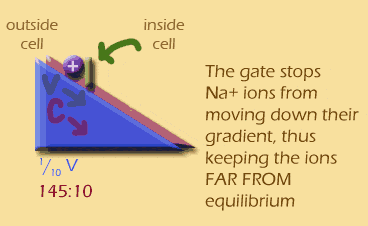At equilibrium, or far from it?
Often when we think of membrane potential, it is in the context of your nervous system. So starting now, we're going to leave cells in your femur, fingertip, and islet of langerhans behind, and focus on neurons.
OK, take a deep breath...
Most materials that you encounter in daily life are either conductors (like copper wire) or insulators (like plastic wrapped around the wire). Cell membranes are different, in that they can rapidly change, depending on their membrane potential -- and nowhere more so than in your nervous system.
The reason these changes can happen rapidly is that, unlike K+, not all of the ions are kept in equilibrium. Exhibit A, the sodium ion:

Sodium ions are kept out-of-equilibrium by "gated" channels in the membrane. These gated channels maintain a concentration gradient which runs in the SAME direction as the cells membrane potential (due mainly to K+) -- both forces want to push Na+ INTO your neurons, and both are blocked by the gated channel. So, sodium is FAR FROM EQUILIBRIUM.
Copyright University of Maryland, 2007
You may link to this site for educational purposes.
Please do not copy without permission
requests/questions/feedback email: mathbench@umd.edu
